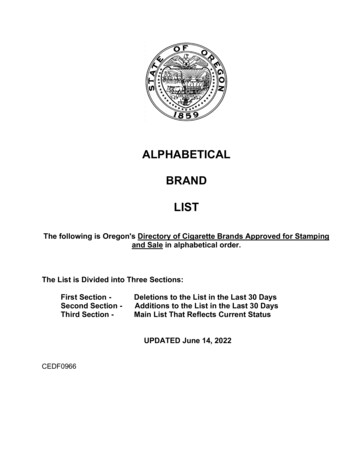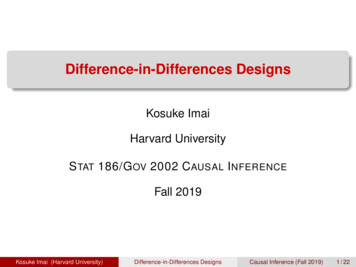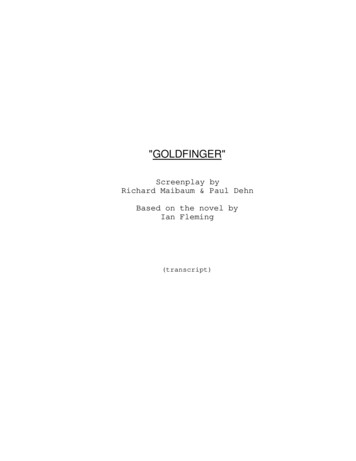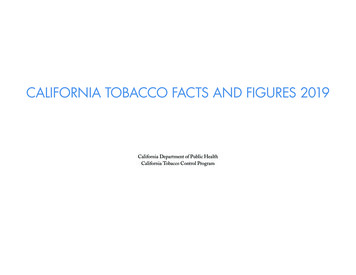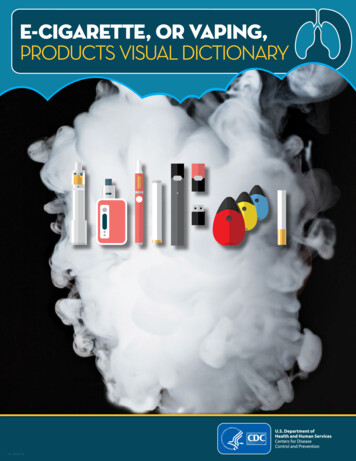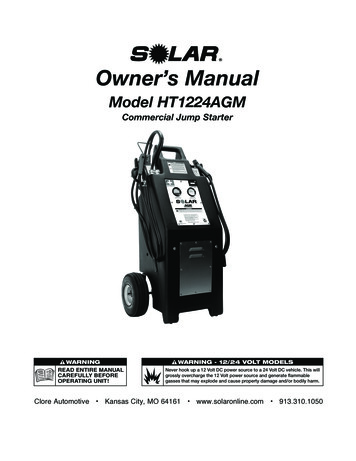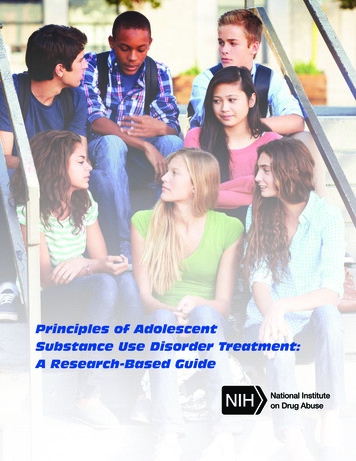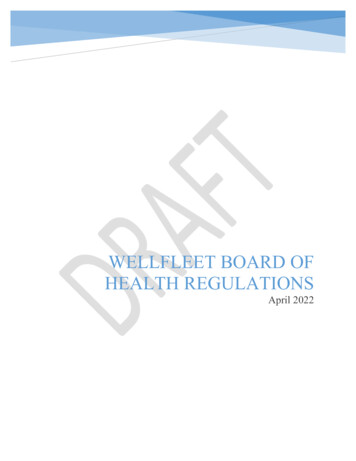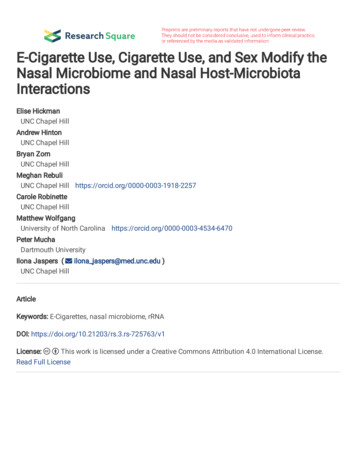
Transcription
E-Cigarette Use, Cigarette Use, and Sex Modify theNasal Microbiome and Nasal Host-MicrobiotaInteractionsElise HickmanUNC Chapel HillAndrew HintonUNC Chapel HillBryan ZornUNC Chapel HillMeghan RebuliUNC Chapel Hill https://orcid.org/0000-0003-1918-2257Carole RobinetteUNC Chapel HillMatthew WolfgangUniversity of North Carolina https://orcid.org/0000-0003-4534-6470Peter MuchaDartmouth UniversityIlona Jaspers ( ilona jaspers@med.unc.edu )UNC Chapel HillArticleKeywords: E-Cigarettes, nasal microbiome, rRNADOI: https://doi.org/10.21203/rs.3.rs-725763/v1License: This work is licensed under a Creative Commons Attribution 4.0 International License.Read Full License
031323334353637383940414243444546Title: E-Cigarette Use, Cigarette Use, and Sex Modify the Nasal Microbiome and Nasal HostMicrobiota InteractionsAuthors: Elise Hickman1,2*, Andrew Hinton3,4,*, Bryan Zorn5, Meghan E. Rebuli1,2, CaroleRobinette1, Matthew Wolfgang5, 6, Peter J. Mucha3,7, Ilona Jaspers1,2#*These authors contributed equally to the published work.#Corresponding authorAffiliations:1Center for Environmental Medicine, Asthma, and Lung Biology2Curriculum in Toxicology & Environmental Medicine3Curriculum in Bioinformatics and Computational Biology4UNC Food Allergy Initiative, School of Medicine5Marsico Lung Institute6Department of Microbiology and Immunology7Department of Mathematics and Department of Applied Physical SciencesUniversity of North Carolina, Chapel Hill, NC, United StatesAbstract (150-word limit)E-cigarettes are often perceived as safer than cigarettes, but previous research suggeststhat e-cigarettes can alter respiratory innate immune function. The respiratory microbiome playsa key role in respiratory host defense, but the effect of e-cigarettes on the respiratory microbiomehas not been studied. Using 16S rRNA gene sequencing on nasal epithelial lining fluid samplesfrom adult e-cigarette users, smokers, and nonsmokers, followed by novel computationalanalysis of pairwise log ratios, we determined that e-cigarette use and smoking causesdifferential respiratory microbiome dysbiosis, which was further affected by sex. We alsocollected nasal lavage fluid for analysis of immune mediators associated with host-microbiotainteractions. Our analysis identified disruption of the relationships between host-microbiotamediators in the nose of e-cigarette users and smokers, which is indicative of disruptedrespiratory mucosal immune responses. Our approach provides a novel platform that robustlyidentifies host immune dysfunction caused by e-cigarette use or smoking.IntroductionApproximately 7 million adults and more than 3.5 million youth are current electroniccigarette (e-cigarette) users.1-3 E-cigarettes heat and aerosolize e-liquids containing nicotine andflavorings dissolved in humectants propylene glycol and glycerin. E-cigarette use has beensteadily increasing over the past decade, especially among teenagers and young adults, reversingthe previous decline in youth tobacco use. 3,4 Public health crises, such as the outbreak of ecigarette and vaping-associated lung injury in 2019-2020 and the ongoing SARS-CoV-2 globalpandemic, highlight the importance of research examining the effects of e-cigarettes onrespiratory immune function.5,6There is emerging evidence that e-cigarettes disrupt respiratory innate immunity.Previous work has demonstrated the potential for e-cigarette toxicity and impairment ofrespiratory immune defense using in vitro and in vivo models as well as in samples from human1
.7-12 For example, e-cigarette users have altered markers of innate immune responses ininduced sputum and bronchoalveolar lavage fluid in comparison with smokers andnonsmokers,8,12 and chronic e-cigarette exposure in mice can dysregulate endogenous lung lipidhomeostasis and innate immunity.11,13 In vitro studies have demonstrated that e-liquids, ecigarette aerosols, and their components can impair the function of ciliated airway cells andrespiratory immune cells.9,14-18 Furthermore, e-cigarette exposure has been shown to enhancebacterial virulence and adhesion to airway cells,19,20 suggesting that e-cigarette exposure mayimpact the respiratory microbiome. However, the effects of e-cigarette use on the respiratorymicrobiome in humans have not been evaluated.The respiratory microbiome includes distinct communities of microbiota along the lengthof the respiratory tract.21 Similar to microbial communities at other body sites, respiratorymicrobiota interface with the host immune system, and dysbiosis of the respiratory tractmicrobiome has been associated with diseases, including cystic fibrosis, chronic obstructivepulmonary disease, asthma, and chronic rhinosinusitis, as well as with disease exacerbations andsmoking cigarettes.21-24 Sampling the nasal microbiome is straightforward in contrast to thelower airway microbiome, which is easily contaminated with oral microbiota during specimencollection.25 In addition, the nose is an important gatekeeper in the respiratory tract, as potentialpathogens must often colonize this region before progressing to the lower respiratory tract.21 Thisrole has become even more clear and relevant with the emergence of SARS-CoV-2, with recentstudies showing associations between the nasal microbiome and SARS-CoV-2 infection. 26,27 Ofnote is that dysbiosis of the nasal microbiome specifically has been associated with smokingcigarettes,23 and gene expression and histopathological changes due to smoking are similar in thenasal and lower airway epithelium,7 supporting the use of the nasal microbiome for studying theeffects of environmental exposures on the respiratory microbiome.Mechanistic study of the human microbiota is an important focus when studying thehuman microbiome, where identifying microbes associated with disease is paramount.28 Touncover complex interactions in microbiome association studies changes to classical statisticalmethods are required.29 In addition, computational methods that robustly integrate disparate datatypes with 16S microbiome data for association testing have been limited.30 In particular,microbiome datasets have interspecies interactions, small sample sizes, high dimensionality(where the number of features greatly exceed the number of samples), are sparse (where the datamatrix contains many zeroes), and when converted to relative abundance are compositional,meaning the total number of reads is not informative.31 Combined, these challenges significantlyconfound the multivariate integrative analysis required to improve our understanding of hostmicrobiome interactions. Thus, novel analytical tools are necessary to uncover true signalshidden within small sample size microbiome data.In this study, we sampled the nasal microbiomes of smokers, nonsmokers, and e-cigaretteusers using a non-invasive absorptive strip to collect nasal epithelial lining fluid. We then usedhigh-throughput sequencing of the bacterial 16S rRNA gene from the strips to identify bacteriapresent and analyze the bacterial composition of the nasal microbiome in our subjects. Becausethese microbial communities are composed of highly interdependent taxa that have complexinteraction patterns, multivariate data analysis is critical to extract biologically relevantinformation.Here, we leverage Selection Energy Permutation 32, a novel multivariate association testthat simultaneously tests associations while identifying robust subsets of pairwise log ratios inthe setting of high-dimensional, low sample size data. These reduced subsets are then used to2
8129130131132133134135136137138integratively analyze nasal microbiome and matched cell-free nasal lavage fluid mediator data todetermine: 1) whether there were significant compositional differences in the nasal microbiomesof E-cigarette users, smokers, and nonsmokers, 2) whether levels of nasal lavage fluid (NLF)mediators are significantly different in e-cigarette users and smokers in comparison withnonsmokers, and 3) whether changes in levels of these mediators correlate with nasalmicrobiome dysbiosis. Our data demonstrate nasal microbiome dysbiosis and unique networks ofhost-microbiota mediators in e-cigarette users and smokers in comparison with nonsmokers. Thisis indicative of disrupted respiratory mucosal immune responses in these groups and potentiallyincreased susceptibility to infection by specific bacterial taxa. We also observed significant sexdifferences in the nasal microbiome, highlighting the importance of including sex as a biologicalvariable in nasal microbiome studies.MethodsSubject recruitment. Nasal epithelial lining fluid (NELF) strips, nasal lavage fluid (NLF), andvenous blood were obtained from healthy adult human e-cigarette users, smokers, andnonsmokers as described previously (Table 1),33 forming our exposure groups. Inclusion criteriawere healthy adults age 18-50 years who are either nonsmokers not routinely exposed toenvironmental tobacco smoke, active regular cigarette smokers, or active e-cigarette users.Active cigarette smoking and e-cigarette use were determined as described previously.7Exclusion criteria were current symptoms of allergic rhinitis (deferred until symptoms resolve),asthma, FEV1 less than 75% predicted at screen, bleeding disorders, recent nasal surgery,immunodeficiency, current pregnancy, chronic obstructive pulmonary disease, cardiac disease,or any chronic cardiorespiratory condition. After the consent process was completed, a medicalhistory and substance use questionnaire was obtained, and subjects were issued a diary todocument smoking/vaping for up to 4 weeks, after which they returned for sample collection. Ecigarette users averaged less than 1.5 cigarettes/day in their smoking/vaping diaries, whilecigarette users ranged from 4.93-20 cigarettes per day in their diaries. To compare demographiccharacteristics between subjects in the different exposure groups, age, BMI, and serum cotininelevels were tested for normality using the Shapiro-Wilk test, and groups were compared usingthe Kruskal-Wallis test followed by the Steel-Dwass method for non-parametric multiplecomparisons (analogous to a one-way ANOVA with Tukey’s HSD for parametric data).Serum Cotinine Measurement. Venous blood was collected in BD Vacutainer serum-separatingtubes (Fisher Scientific, Waltham, MA) and allowed to clot for a minimum of 15 minutes atroom temperature. The blood was then centrifuged at 1200 x g for 10 minutes, and the serumlayer was transferred to a fresh tube and stored at -80 C until samples were collected from allsubjects. Serum was assayed for cotinine, a metabolite of nicotine that can be measured as abiomarker of nicotine consumption, using a commercially available ELISA kit (Calbiotech,Mannheim, Germany) per manufacturer’s instructions. Absorbance was read on a CLARIOstarplate reader (BMG Labtech, Ortenberg, Germany). The limit of quantification for serum cotininewas 5 ng/mL. For samples below the limit of detection, a value of zero was assigned. Serum wasnot available for one subject in the cohort.NELF Strip Metagenomic Sequencing. DNA was extracted from whole NELF strips usingPowersoil DNA Isolation Kit (MoBio Laboratories). Sequencing libraries were prepared as3
72173174175176177178179180181182183184previously described.34 Samples were sequenced on an Illumina MiSeq kit version V3 2x300paired end over the V3-V4 bacterial 16s gene. Raw sequencing data were demultiplexed andprocessed to generate a table of operational taxonomic units (OTUs). Specific primer schema,qPCR data, and the OTU table (having at least 10 sequences per OTU across all samples) areprovided in the supplement. Raw sequence data have been uploaded under the BioProjectaccession number PRJNA746950 within the Sequence Read Archive.NLF Processing and Soluble Mediator Measurement. Cell-free nasal lavage fluid was obtainedvia processing of raw nasal lavage fluid as described previously.35 Briefly, raw nasal lavage fluidfrom each nostril was pooled and centrifuged at 500x g through a 40 µm strainer for 10 minutes.Supernatant (cell-free NLF) was collected and stored at -80 C until samples were collected fromall subjects. Cell-free NLF was assayed for mediators of host-microbiota interaction (neutrophilelastase, immunoglobulin A (IgA), lactoferrin, lysozyme, interleukin 8 (IL-8), alpha-defensin 1,beta-defensin 1, beta-defensin 2, cathelicidin (LL-37)) using commercially available ELISA kitsper manufacturer’s instructions as described in Supplementary Table 1. Absorbance was read ona CLARIOstar plate reader. For samples below the limit of detection, a value of ½ the loweststandard was assigned. Cell-free nasal lavage fluid was not available for one subject in the cohort(Figure S1).Sequencing Data Processing and Filtering. Five samples were removed from the dataset due to alow number of reads (Figure S1). A spiked pseudomonas positive control was identifiedcorrectly as pseudomonas. To control for potential contamination on the NELF strips, thedecontam R package was used to remove contaminants.36 This package uses an algorithm thattakes into account the relative abundance of OTUs in samples and controls to remove the mostlikely contaminants and has been shown useful for respiratory samples.37 This reduced thenumber of OTUs from 5346 to 4677. Alpha diversity measures (Observed, Chao1, ACE,Shannon, Simpson, Fisher) were calculated using the phyloseq R library before trimming OTUcounts less than 5 for downstream analysis. This brought the number of OTUs to 3059 fordownstream analysis.Alpha diversity. Shannon and Simpson diversity indices were computed for each sample.Diversity indices were tested for normality using the Shapiro-Wilk test and further statisticaltests to compare groups were carried out using the appropriate parametric (two-tailed t-test,ANOVA) or non-parametric (Kruskal-Wallis, Steel Dwass) tests. These analyses were performedusing JMP Pro 14 and GraphPad Prism 8.Nasal Microbiome Compositional Data Analysis. To limit spurious findings and becauseabsolute sequencing counts are uninformative,31,38,39 compositional data analysis (CoDA)40 wascarried out on the OTU count table after aggregating OTUs (O 3059) by family (min. levelassigned) and genera (max level assigned) and removing taxa not present in at least 20% ofsamples. The 20% sparsity threshold was selected to maximize class-specific information (Sex,Exposure group) while ensuring the microbial signatures were robust and contained minimalnoise due to excessive sparsity. After aggregating OTUs, we define the taxa count matrix, X ℝ!"# , with n 62 samples and p 143 taxa. The closure operator, 𝐶[ ], was then used to mapthe count data of each element 𝑥 % of X onto its corresponding coordinate on the unit-sumsimplex, defining X & 𝐶[X] in terms of matrix elements as4
185&𝑥 % (𝐶[𝑿]) % 2203204205𝑥 %( ')* 𝑥 'Because the presence of zeros is a major limitation of the log ratio transformation essential toCoDA, all zeroes must be robustly imputed to non-zero values. To overcome this we use theratio-preserving multiplicative replacement strategy which has been shown to have severaltheoretical advantages over simple additive replacement:41 we set the 𝛿 imputed values to asingle constant equal to the smallest nonzero value encountered in X & . From this, we imputezeros and replace X & with Z defined in matrix elements as:𝑧 % 𝛿,&𝑥 % 0& 81 ; 𝛿 𝑥 % , ' ,!" ) &𝑥 % 0Partial redundancy analysis to remove variation due to Sex. To remove the significant effect ofSex (which otherwise obscures the exposure group effect) on Z, partial Redundancy Analysis(pRDA )42 was used. Here we encode the Sex variable into the design matrix S. Additionally, toensure multiple regression computations used in pRDA are performed on symmetric vectors inreal space that preserves the inter-sample Euclidean distances, a center log ratio (clr)transformation was applied40 to Z, defining the clr values C for each sample as 𝒄 @𝑐* , , 𝑐# Csuch that:z/.c./ log H K where 𝐺 8Q 𝑧 % 221With C defined, pRDA was carried out in the vegan R package.43 Multivariate linear regressionof C on S (i.e. computed as a series of multiple linear regression on individual features) was usedto produce the fitted values CR . To remove the Sex effect as in pRDA, the adjusted values of Cwere computed by 𝐏 𝐂 CR where CR contains all variation attributable to Sex. With 𝐏 definedin Euclidean coordinates which are not suitable for downstream pairwise log ratiotransformations, an inverse clr transformation was applied to map the adjusted coordinates backto the unit-sum simplex. The Sex adjusted relative abundance matrix M with elements 𝑚 % iscomputed as:𝑚 % expX𝑝 % Z# ')* exp(𝑝 ' )Nasal Microbial Signature identification using Selection Energy Permuation. To identifymicrobial log ratio signatures in the setting of high-dimensional low sample size data we utilizedthe recently developed Selection Energy Permutation (SelEnergyPerm) method, which has beenshown to have increased statistical power over several existing multivariate hypothesis testing5
222223224225226227228methods under hypothesis testing settings like this.32 The SelEnergyPerm method simultaneouslyselects a reduced subset of log ratios while maximizing the association between groups. Let thegroup distributions be defined as 𝑋 ℝ0 , 2 and 𝑌 ℝ3 , 2 . In this work, we useSelEnergyPerm with the energy statistic (E-statistic)44 defined byℇ0,3 (𝑋, 𝑌) 2𝐴 𝐵 𝐶,where A, B, and C are specified, in terms of the vectors of ℝ2 indexed by sample, by1𝐴 ; ;e𝒙 𝒚% e ,𝑛𝑚02293 )* 52462472482492502512522532542552562571𝐵 5 ; ;e𝒙 𝒙% e ,𝑛00 )* %)*1𝐶 5 ; ;e𝒚 𝒚% e𝑚33 )* %)*From this, the pooled multi-class (#classes (c) 2) E-statistic becomes𝑆 ;*6%7'6'i𝑛% 𝑛'𝑛% 𝑛'lmℇ(𝑋 , 𝑋 )n2𝑁𝑛% 𝑛' !# ,0" % 'The pooled E-statistic is then maximized using forward selection on a subset selected from thefull set of pairwise log ratios to explain maximal variation when compared to the full set ofpairwise log ratios. Similar to the approach in Greenacre et al.,45 the reduced subset of log ratios#(#9*)are selected from the2-dimensional feature space (all pairs). However, there are 𝑝#95possible ways to select a subset of log ratios that explain the total log ratio variance. Toovercome this, SelEnergyPerm scores each log ratio using the differential compositionalvariation scoring method and then iteratively computes acyclic subsets of log ratios, 32 withpermutation testing via Monte Carlo sampling46 to assess the significance and prevent overfittingof the log ratio signature. Specifically, given a log ratio signature discovered with true labels,SelEnergyPerm tests if the observed pooled E-statistic (𝑆 ) is more extreme than E-statisticssampled from the permutation distribution of log ratio signatures selected under random labels(𝑆 , indexing different random-label samples). With 𝛾 such E-statistics randomly sampled fromthe permutation distribution the one-sided p-value becomes 1 )* 𝐼(𝑆 𝑆 )𝑝̂ 𝛾 1As expected, we find that removing large numbers of uninformative features increases statisticalpower in the high-dimensional low-sample-size setting. To identify the Sex nasal microbialsignatures in this study we utilized Z with labels 𝑆𝑒𝑥 and for the Exposure group microbialsignature we utilized M with labels 𝑆𝑢𝑏𝑗𝑒𝑐𝑡 𝐺𝑟𝑜𝑢𝑝. Using these data, we applied theSelEnergyPerm method with default settings using 200 permutations. Additionally, to reducenoise from sparse features, we further reduced taxa included in the analysis by first identifyingthe number of taxa to include in the microbial signature. We tested the following subsetsizes: [5,10,20,40,60,80,100]. Applying the SelEnergyPerm method on each subset andnormalizing the energy statistic44 we selected the subset that maximized the normalized pooledenergy statistic (Figure S2) and then tested if the observed 𝑆 was more extreme than random. In6
91292293294295296297298299300301302303this way, we increase the statistical power of our analysis and reduce the chance of overfitting.While this is good for identifying associations, it can come at the expense of reduced overalldiscriminatory potential.Network Visualization of Microbial signature. To visualize the microbial log ratio signatures, weconstructed undirected graphs connecting the key taxa (vertices/nodes) by edges representing theformation of a ratio between two taxa with edge weight corresponding to the between-groupKruskal-Wallis H-statistic. While the full log ratio structure is directed in distinguishingnumerators from denominators, directedness in the visualizations used here does notfundamentally change our interpretation. Graphs were visualized using Gephi47 and R-igraph.48Multivariate statistical test for microbial signals. To confirm associations between microbial logratio signatures and Sex/Exposure group multivariate hypothesis testing was done usingpermutational multivariate analysis of variation49 and implemented using the R vegan package.43Unsupervised lower-dimensional projections of samples and group centroids were done usingprincipal coordinate analysis (PCoA) and were implemented using the R stats package.Partial Least Squares Discriminate Analysis. We utilized partial least squares discriminateanalysis (PLS-DA),50,51 a versatile multivariate statistical regression technique, to model andunderstand the relationship between Sex/Exposure group to their microbial signatures. Shown tohave reliable performance on compositional and genomic datasets,52,53 PLS-DA models performclassification, inference, and are inherently linear thus offering improved model interpretability.We specified a priori the number of PLS-DA components (ncomp) as follows: for the betweenSex nasal microbial signature, ncomp 1; for the between Exposure group nasal microbialsignature, ncomp 2. Model fitting was done using the R caret 54 plsda function, with latentspace projections and loadings extracted from the final models fit using all samples using Rcaret.54 PLS-DA biplots were created by scaling and superimposing the loading vectors onto thescore coordinates extracted from the final fitted model. PLS-DA biplots were visualized usingthe R ggplot2 package.55Receiver operating characteristic curve analysis and PLS-DA performance metric. Tounderstand how well the binary PLS-DA models discriminate between Sex using the nasalmicrobiome signature, we utilized the area under the receiver operating characteristic metric,AUC, which represents the probability that a randomly selected instance of class 1 will be rankedhigher than a randomly selected instance of class 2.56 Additionally, to understand thediscriminatory potential of the ternary PLS-DA Exposure group models, the multi-class AUCmetric was used. The multi-class AUC generalizes binary AUC through pairwise class AUCaveraging and has the useful property of being independent of cost and priors as in AUC whilehaving a similar interpretation to misclassification rate.57 AUC metrics were estimated usingrepeated k-fold cross-validation.58 The R pROC package59 was used to compute all AUCmetrics. ROC curves, which graph the false positive and true positive rate of a classifier over arange of thresholds, were computed using the R pROC package59 and visualized using the Rggplot2 package.55NLF mediator and microbiome data integration. We define the nasal lavage data matrix, L ℝ! " , where n 66 samples and f 7 mediators. Treating the data as relative such that sample-7
37338339340341342343344345346347348wise absolute concentrations in our study are considered unimportant (Figure S3A), zeroes wereimputed after applying the closure operator to L as described in our compositional data analysismethods. From this, we define L′ ℝ! " , with k 21, to include all pairwise log ratios from L.To remove uninformative NLF mediators, we computed the differential compositional variation(DCV) score 32 and assigned each NLF mediator log ratio a score by averaging the within-foldDCV score using 20 repeats of 10-fold cross-validation. NLF log ratios with a DCV score 0were considered uninformative and were removed (Figure S3B). From this ' was reduced to L‚ ℝ! " where k 4 (Figure S3C) log ratios. To test for univariate associations between NLFmediator log ratios and Exposure group the Kruskal-Wallis test was applied followed bypairwise Wilcoxon rank-sum testing if 𝛼 0.05. The nasal microbiome signal was obtained byR ℝ! " ? where n 62 and r 9 log ratios.applying the SelEnergyPerm method to M to get MConcatenating these data, we define the integrated NLF mediator and nasal microbiome matrixas D ℝ! " where n 61 (6 samples were removed due to either missing nasal microbiome orNLF data) and f 13 (4-nasal lavage and 9 microbiome log-ratio features). Exposure groupR , and D using multi-class AUC from 50discrimination was estimated separately for each of L‚, Mrepeats of 10-fold cross-validation using 2-component PLS-DA models. Multi-class AUCR , and D were compared between groups using the non-parametric Wilcoxonestimates using L‚, Mrank-sum test.Nasal NLF mediator and microbiome association analysisR.A final 2-component PLS-DA model to discriminate between exposure groups was fit to MUsing dimensionality reduction inherent to PLS-DA, the first PLS-DA component (explainingthe most variation) was extracted as a latent variable for further analysis. Pearson’s correlationcoefficients (PCC) and subsequent p-values were computed between the first PLS-DAcomponent and L’’ represent the reduced nasal microbiome exposure group signature. PCC pvalues, adjusted for multiple comparisons (q-value) using the Benjamini-Hochberg (BH)correction,60 were considered significant if q 0.10. These analyses were carried out using theR stats and caret packages.Between Exposure group Correlation analysis. Partitioning the samples of D into 3 matricesbased on exposure group (nonsmokers, e-cig users, or smokers), we calculate all pairwise PCCand p-values between features for each group. We also report q-values after adjusting formultiple comparisons within each group using the BH method. Correlations were consideredsignificant if 𝑞 0.10. Significant PCC within each subject were then aggregated across allexposure groups and visualized as a graph using the R igraph package.48Confidence Intervals and univariate statistical test for log ratios. Log ratio 95% confidenceinterval estimates were calculated by𝐶𝐼 𝑥Š@ 1.96𝑠 𝑛where for the ith log ratio, 𝑥Š@ sample mean, 𝑠 sample standard deviation and 𝑛 numbersamples. Log ratios with confidence intervals bounds that do not include 0 are interpreted asenriched on average for the numerator if 𝑥̅ 0 or denominator if 𝑥̅ 0. The Kruskal-Wallis8
82383384385386387388389390391392393394and Wilcoxon rank-sum test were used for univariate comparisons of log ratios between Sex orExposure groups. Moreover, p-values were adjusted for multiple comparisons using the BHcorrection using the R stats library and are reported as q-values.ResultsSubject DemographicsDemographic, questionnaire, and smoking/vaping diary data are summarized in Table 1. Thestudy cohort was comprised of 30% nonsmokers (n 20), 42% e-cigarette users (n 28), and28% smokers (n 19) with at least n 8 per sex within each exposure group. E-cigarette userswere significantly younger (26.39 1.44) than nonsmokers (30.75 1.32) and smokers (31.89 1.91) (p 0.05). BMI did not differ significantly between the exposure groups. Questionnairesand smoking/vaping diaries were completed for 95% (19/20) of nonsmokers and 100% of ecigarette users and smokers. However, there was variability in the completeness of diaries filledout by e-cigarette users, particularly for the e-cigarette use parameters (mL/day, puffs/day,nicotine concentration, flavor, device). Cigarette users smoked an average of 12.68 0.96cigarettes per day, whereas 25% (7/28) of e-cigarette users smoked a cigarette during the diaryperiod with an average of 0.14 0.07 cigarettes per day, while 13 e-cigarette users reported puffsper day and 16 reported mL e-liquid/day and e-liquid nicotine concentration in mg/mL. These ecigarette users averaged 53.90 16.54 puffs/day, 3.60 0.70 mL of e-liquid, and 19.43 4.92mg/mL nicotine in e-liquids. One smoker reported vaping on one day of the diary, which is thereason for the non-zero values for e-cigarette use parameters in the smoker category.Nonsmokers did not report previous cigarette smoking or marijuana use, whereas 79% (22/28) ofe-cigarette users were former cigarette smokers, while 14% (4/28) of e-cigarette users and 21%(4/19) of smokers reported marijuana use in their diaries. Cotinine, a metabolite of nicotine, wasnot detectable in the serum of nonsmokers and was significantly elevated in the serum of ecigarette users (127.99 15.42) and smokers (170.16 21.41) in comparison with nonsmokers(p 0.0001), as expected.Nasal Microbiome CharacteristicsThe 4677 OTUs included in the dataset represented OTUs from 19 unique phyla and 225 uniquegenera. The top four most abundant phyla by average relative a
2 47 subjects.7-12 For example, e-cigarette users have altered markers of innate immune responses in 48 induced sputum and bronchoalveolar lavage fluid in comparison with smokers and 49 nonsmokers,8,12 and chronic e-cigarette exposure in mice can dysregulate endogenous lung lipid 50 homeostasis and innate immunity.11,13 In vitro studies have demonstrated that e-liquids, e-

